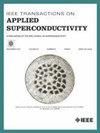扭曲叠带高温超导电缆动态损耗和磁化损耗二维数值分析方法的发展
IF 1.8
3区 物理与天体物理
Q3 ENGINEERING, ELECTRICAL & ELECTRONIC
引用次数: 0
摘要
扭曲、叠带高温超导电缆,如分隔的前真空压力浸渍、绝缘、部分转置、挤压和滚压成型(PIT-VIPER),已成为核聚变磁体设计的关键候选材料。这些电缆通常包含四叠60-100个磁带,由于三维模拟的高计算要求,对电缆中的交流损耗进行建模是一项重大挑战。在这项工作中,我们提出了一种二维扫描方法的发展,该方法将扭曲几何结构划分为多个横截面平面,从而大大减少了模拟时间。扫描方法在携带直流电流的PIT-VIPER电缆的背景下得到了彻底的验证,并暴露在温度为20 K的高达8 T的交变磁场中。模型采用H-$\phi $公式实现,每堆栈最多包含20个磁带。对于超过阈值的应用领域,二维扫描显示与三维参考模型的磁化和动态损耗成分的一致性非常好,平均在2%以内。通过仔细选择扫描位置,即使使用少量的二维模拟也可以实现高精度。虽然二维方法不能完全捕获在低磁场下多磁带堆叠中的复杂屏蔽效应,但它仍然提供了可靠的平均损耗估计。该方法也很容易适用于其他应用和电缆架构,包括圆芯导体(CORC)和同轴设计。本文章由计算机程序翻译,如有差异,请以英文原文为准。
Development of a 2-D Method for Numerical Analysis of Dynamic and Magnetization Loss in Twisted, Stacked-Tape HTS Cables
Twisted, stacked-tape high-temperature superconducting cables, such as partitioned formervacuum pressure impregnated, insulated, partially transposed, extruded, and roll-formed (PIT-VIPER), have become key candidates for use in fusion magnet designs. Modeling ac loss in these cables, which typically contain four stacks of 60–100 tapes, presents a major challenge due to the high computational demands of 3-D simulations. In this work, we present a development of a 2-D scanning method, which divides the twisted geometry into multiple cross-sectional planes, achieving a considerable reduction in simulation time. The scanning method is thoroughly verified in the context of PIT-VIPER cables carrying dc current and exposed to an alternating magnetic field of up to 8 T at a temperature of 20 K. Models are implemented with H-$\phi $
求助全文
通过发布文献求助,成功后即可免费获取论文全文。
去求助
来源期刊

IEEE Transactions on Applied Superconductivity
工程技术-工程:电子与电气
CiteScore
3.50
自引率
33.30%
发文量
650
审稿时长
2.3 months
期刊介绍:
IEEE Transactions on Applied Superconductivity (TAS) contains articles on the applications of superconductivity and other relevant technology. Electronic applications include analog and digital circuits employing thin films and active devices such as Josephson junctions. Large scale applications include magnets for power applications such as motors and generators, for magnetic resonance, for accelerators, and cable applications such as power transmission.
 求助内容:
求助内容: 应助结果提醒方式:
应助结果提醒方式:


